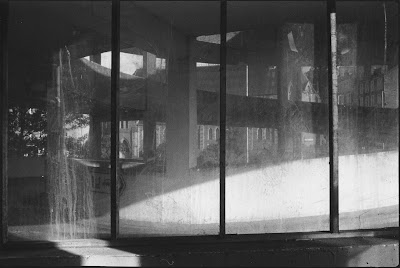Morning folks - hope everyone is well.
The Winter is starting to draw in with a great rapidity that I never like, though this year I am determined to embrace it more and not be so bothered that it is getting dark at 3.30PM!
Anyway, without further ado, I have recently been using a couple of truly old . . well, older than me . . . photographic devices - it's been fun and is the pure antithesis of today's 'do everything' cameras.
No, they're not LF cameras either, nor is it the Mamiya Press (which is kind of like using a LF camera, but with a handle - you go through similar processes and checklists before every exposure . . and after too!) No these were different from the point of view of snapability.
Take a bow please, a Canon L2/35mm f3.5 Nikkor and a Rollei Old Standard. The former from 1958/1951 and the latter from 1934/35.
.jpeg) |
They've been fun to use and like anything older, required a wee bit of tweaking from me to get results I was happy with.
In the Canon/Nikkor case, that was fitting a lens hood (I ended up using my 5cm FISON - you would think it would vignette, but it doesn't, and it clamps like a champ!) and not being too radical with my choice of shutter speeds. Whether it is because of all the gripping and scraping I have been doing as DIY or an age thing, or possibly even the weight of the camera - it is very light - I found that it is quite sensible, where possible, to decide on 1/30th as my slowest shutter speed.
It does rather limit your choices, but what can you do . . if you want to explore fun in an ancient style, then maximise your potential.
The Old Standard was a bit different, in that you can sort of use your body and a wall as a tripod whilst gently pulling down on the neck strap - it is a surprisingly stable way of doing things, even with a camera as light as the Rollei.
And it is a light Rollei - certainly lighter than my T.
It makes the likes of a Mamiya C330 look and feel like a house brick from a black hole!
The Tessar is also of a different quality to the Tessar on my T.
Bruce would call this UB (Unsubstantiated Bollocks) but to my eyes it is true.
The T's Tessar is a single coated lens; the early Tessar on the Standard is uncoated and therein lies its magic - in much the same way that early Leitz Elmars have that glowy look to them (more UB?) the same can be said of the Old Standard.
I can only imagine what it would be like with its proper hood.
Anyway, here's some photies . . . oh and I forgot to say that using such ancient machinery may well result in the likes of the following comment (which I loved):
"That's an affie auld camera!"
Probably my favourite carpark picture - everything fell into place and, despite the sun falling on the plexiglass window, the dark splendours of the concrete cathedral have been revealed. The 35mm f3.5 Nikkor is a fine lens - I feel very priviledged to be able to use it.
This is printed on Ilford MGRC at Grade 4. Film was HP5 at EI 200 developed in HC110 (Dilution B) for a total of 8 minutes (I stood it from 6) - a nice combo and the inherent mild contrastiness of HC helped to contribute to the lack of contrast in the scene.
Sadly the 'waterfall' has since gone.
These are the Old Standard - I like them both.
The first was printed at Grade 4.5 on some very old MGRC - I can go no higher using the DeVere's colour wheels! The photograph, is pretty much exactly how I saw it, and the Tessar has rendered the scene beautifully softly.
The second was printed at Grade 4'5 too.
One wonders how it is possible to go, in a print, from really soft (the building with the Paper (white) Sun behind it to incredibly hard (the woman's feet and the bright pavement).
There was no split grading involved and I can only assume the camera has contributed.
There's an enormous amount of detail in there too - not too shabby for a nearly 90 year old lens.
Film was the combo of out of date (2009!) Pan F and Fomadon R09 at 1+50.
VERY GENTLE agitation to 10 minutes and then let it stand to 12.
I'm not normally a 'street' person, but I like this a great deal - it looks old despite the modern bus shelter.
The older I get the more I realise that Rodinal can be used almost universally for most subjects - a wonderful developer and if I only had to have one, then it would probably be it.
And that's it - short and sweet.
The two old 'uns are currently having a natter about the state of the world over a cup of Darjeeling and a couple of hobnobs.
Until the next time, over and oot and keep taking the pills.
H xx

.jpeg)
.jpeg)